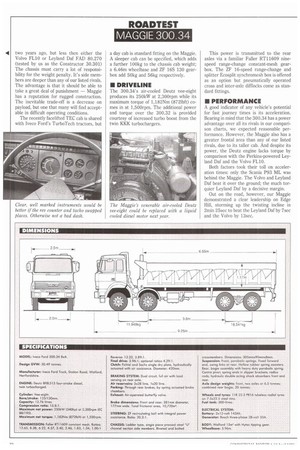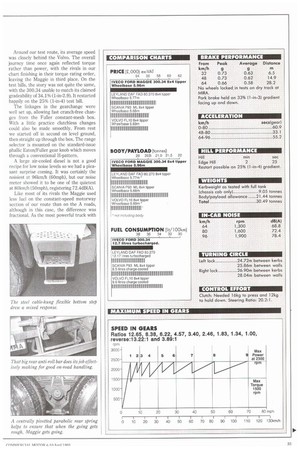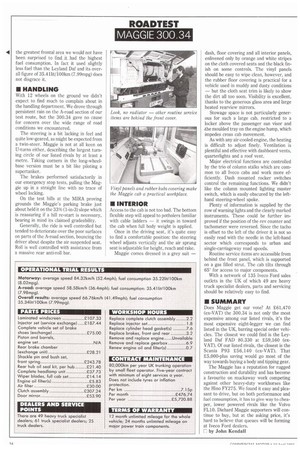ROADTEST MAGGIE 300.34
Page 34

Page 35

Page 36

If you've noticed an error in this article please click here to report it so we can fix it.
two years ago, but less then either the Volvo FL10 or Leyland Daf FAD 80.270 (tested by us as the Constructor 30.301) The chassis must carry a lot of responsibility for the weight penalty. It's side members are deeper than any of our listed rivals. The advantage is that it should be able to take a great deal of punishment — Maggie has a reputation for rugged construction. The inevitable trade-off is a decrease on payload, but one that many will find acceptable in difficult operating conditions.
The recently facelifted TEC cab is shared with lveco Ford's TurboTech tractors, but a day cab is standard fitting on the Maggie. A sleeper cab can be specified, which adds a further 100kg to the chassis cab weight; a 6.46m wheelbase and ZF 16S 130 gearbox add 50kg and 56kg respectively.
• DRIVELINE
The 300.34's air-cooled Deutz vee-eight produces its 250kW at 2,300rpm while its maximum torque of 1,182Nm (872Ibft) comes in at 1,500rpm. The additional power and torque over the 300.32 is provided courtesy of increased turbo boost from the twin KKK turbochargers. This power is transmitted to the rear axles via a familiar Fuller RT11609 ninespeed range-change constant-mesh gearbox. The ZF 16-speed range-change and splitter Ecosplit synchromesh box is offered as an option but pneumatically operated cross and inter-axle difflocks come as standard fittings.
• PERFORMANCE
A good indicator of any vehicle's potential for fast journey times is its acceleration. Bearing in mind that the 300.34 has a power advantage over all its rivals in our comparison charts, we expected reasonable performance. However, the Maggie also has a greater frontal area than any of our listed rivals, due to its taller cab. And despite its power, the Deutz engine lacks torque by comparison with the Perkins-powered Leyland Daf and the Volvo FL 10.
Both factors took their toll on acceleration times: only the Scania P93 ML was behind the Maggie. The Volvo and Leyland Daf beat it over the ground; the much torquier Leyland Daf by a decisive margin.
Out on the road, however, our Maggie demonstrated a clear leadership on Edge Hill, storming up the twisting incline in 2min 25sec to beat the Leyland Daf by 7sec and the Volvo by 13sec. Around our test route, its average speed was closely behind the Volvo. The overall journey time once again reflected torque rather than power, with the rivals in our chart finishing in their torque rating order, leaving the Maggie in third place. On the test hills, the story was not quite the same, with the 300.34 unable to match its claimed gradeability of 34.1% (1-in-2.9). It restarted happily on the 25% (1-in-4) test hill.
The linkages in the gearchange were well set up, allowing fast crunch-free changes from the Fuller constant-mesh box. With a little practice clutchless changes could also be made smoothly. From rest we started off in second on level ground, then straight up through the box. The range selector is mounted on the standard-issue phallic Eaton/Fuller gear knob which moves through a conventional Li-pattern.
A large air-cooled diesel is not a good recipe for low noise levels so we had a pleasant surprise coming. It was certainly the noisiest at 96km/h (60mph), but our noise meter showed it to be one of the quietest at 80km/h (50mph), registering 72.4dB(A).
Like most of its rivals the Maggie used less fuel on the constant-speed motorway section of our route than on the A roads, although in this case, the difference was fractional. As the most powerful truck with the greatest frontal area we would not have been surprised to find it had the highest fuel consumption. In fact it used slightly less fuel than the Leyland Daf and its overall figure of 35.411it/1001on (7.99mpg) does not disgrace it.
• HANDLING
With 12 wheels on the ground we didn't expect to find much to complain about in the handling department. We drove through persistent rain on the A-road section of our test route, but the 300.34 gave no cause for concern over the wide range of road conditions we encountered.
The steering is a bit lacking in feel and quite low-geared, as might be expected from a twin-steer. Maggie is not at all keen on U-turns either, describing the largest turning circle of our listed rivals by at least a metre. Taking corners in the long-wheelbase version must be a bit like piloting a supertanker.
The brakes performed satisfactorily in our emergency stop tests, pulling the Maggie up in a straight line with no trace of wheel locking.
On the test hills at the MIRA proving grounds the Maggie's parking brake just about held it on the 33% (1-in-3) slope which is reassuring if a hill re-start is necessary, bearing in mind its claimed gradeability.
Generally, the ride is well controlled but tended to deteriorate over the poor surfaces on parts of the A-road section, bouncing the driver about despite the air suspended seat. Roll is well controlled with assistance from a massive rear anti-roll bar.
• INTERIOR
Access to the cab is not too bad. The bottom flexible step will appeal to potholers familiar with cable ladders it swings in toward the cab when full body weight is applied.
Once in the driving seat, it's quite easy to find a comfortable position: the steering wheel adjusts vertically and the air sprung seat is adjustable for height, reach and rake.
Maggie comes dressed in a grey suit dash, floor covering and all interior panels, enlivened only by orange and white stripes on the cloth covered seats and the black finish on some controls. The vinyl panels should be easy to wipe clean, however, and the rubber floor covering is practical for a vehicle used in muddy and dusty conditions but the cloth seat trim is likely to show the dirt all too soon. Visibility is excellent, thanks to the generous glass area and large heated rearview mirrors.
Stowage space is not particularly generous for such a large cab, restricted to a locker above the passenger sun visor and the moulded tray on the engine hump, which impedes cross cab movement.
As with any air-cooled engine, the heating is difficult to adjust finely. Ventilation is plentiful and effective with dashboard vents, quarterlights and a roof vent.
Major electrical functions are controlled by the trio of column stalks which are common to all Iveco cabs and work more efficiently. Dash mounted rocker switches control the remaining functions. We didn't like the column mounted lighting master switch, which is easily obscured by the lefthand steering-wheel spoke.
Plenty of information is supplied by the row of warning lights and the clearly marked instruments. These could be further improved if the position of the rev counter and tachometer were reversed. Since the tacho is offset to the left of the driver it is not so easily read with the needle in the left-hand sector which corresponds to urban and single-carriageway road speeds.
Routine service items are accessible from behind the front panel, which is supported on a gas filled strut. The cab tilts through 65° for access to major components.
With a network of 135 Iveco Ford sales outlets in the UK of which 49 are heavy truck specialist dealers, parts and servicing should be relatively easy to find.
• SUMMARY
Does Maggie get our vote? At £61,470 (ex-VAT) the 300.34 is not only the most expensive among our listed rivals, it's the most expensive eight-legger we can find listed in the UK, barring special order vehicles. The closest we could find is the Leyland Daf FAD 80.330 at £59,160 (exVAT). Of our listed rivals, the closest is the Scania P93 £56,140 (ex-VAT). That £5,000-plus saving would go most of the way towards buying a body and tipping gear.
The Maggie has a reputation for rugged construction and durability and has become a favourite on muckaway work competing against other heavy-duty workhorses like the Hino FY275. We found it easy and pleasant to drive, but on both performance and fuel consumption, it has to give way to cheaper, lower powered rivals like the Volvo FL10. Diehard Maggie supporters will continue to buy, but at the asking price, it's hard to believe that queues will be forming at Iveco Ford dealers.
FT by John Kendall












































































































